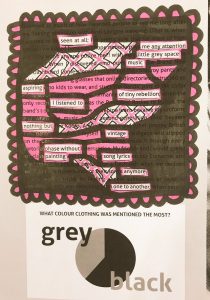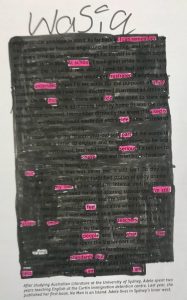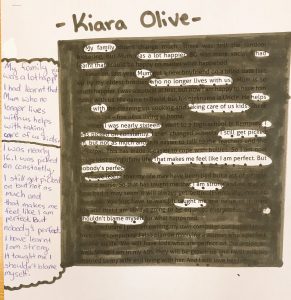In Indigenous cultures around the world—including Aboriginal and Torres Strait Islander cultures— storytelling is an important means by which knowledge and histories are shared between people and communicated from one generation to the next. We are all made up of stories. Stories that family and friends share with us, our own stories, stories that tell us information about who we are, where we come from and what is important to us. Learning From Legacy: Healing Our Country is an acknowledgment and tribute to the importance of these stories. These writing activities direct students to research and engage with the words of Aboriginal and Torres Strait Islander people through a variety of text types and develop their own creative responses to the content they engage with. These activities introduce students’ to a range of pre-writing techniques that will enhance their storytelling skills and inspire their creativity and confidence in developing their own piece of creative writing.
Story Factory online writing workshop.
Our partners at the Story Factory created this exclusive writing workshop for students on personification for the 2023 SRC ‘What Stories Will You Dream’.
We have now made the video available to everyone! View the workshop with students and work through these teaching worksheets.
Explore the world of poetry with Paul Kelly. This interactive lesson is a deep dive through different poems that have both inspired and challenged Kelly throughout his life.
In this activity students will research and select three quotes by Aboriginal and Torres Strait Islander people. These quotes can be excerpts from interviews, songs, stories, articles or any other text types students wish to engage with. Students will create a collection of short factual, instructive, personal, aspirational and or poetic phrases that include the quotes from their chosen sources and their own brief reflection (1-2 sentences) on what they have learned from engaging with their chosen text. They will then place these in locations around the school for other students to find in a treasure hunt! The aim of this activity is to:
Either as a class, in small groups or individually students will research, read and comment upon various texts that are relevant to the theme Learning From Legacy: Healing Our Country and to reconciliation. As a starting point why not look at our Resources page. Each student will highlight 3-4 short phrases that either inspire them, prompt a response and or cause them to reflect on the key themes.
Step 2: write and place Students will write their chosen quotes on small pieces of coloured paper and stick these in locations around the school. As the students complete the writing component of this activity they can be invited to go and place their three quotes in the designated areas within the school. Teachers may like to give students direction as to what locations they can use for the treasure hunt. Encourage students to be creative and decorate the pieces of paper that will be displayed around the school!
Step 3: the search
Once all students have completed writing and placing their quotes, the search begins. Individually or in small groups students can be invited to explore the designated areas around the school and playground to find 3-4 quotes each that appeal to them. Each student will need to keep the quotes they have found.
Step 4: share and discuss
When all students have a collection of found quotes they will return to the classroom and take turns to reading aloud and discussing the phrases they have chosen and why they selected them.
Step 5: reflection and writing development
Based on the class discussions encourage students to write a reflection about what they have learned from participating in this activity. This reflection may form the basis for the development of their own creative writing piece or art submission. Look at Create Art or Create Writing and use the content provided to explore your chosen medium and develop an entry.
In this activity students will check out Kirli Saunders’s works, such as The Incredible Freedom Machines (2018) and Kindred (2019) and answer a list of questions reflecting on her works and her writing process. Kirli is a proud Gunai woman, with ties to the Yuin, Gundungurra, Gadigal and Biripi people. She currently resides in Dharawal Country.
The aim of this activity is to:
Creating postcards from the future is an excellent way to explore this year’s theme and could easily become some students writing and/or art entry. We encourage students to be brave and imagine their ideal reconciled Australia, via creative imagery and in words. This activity requires some knowledge of what reconciliation means and should follow at least one of the themed activities or a discussion based on our research and reconciliation pages. These postcards may become your Art Entry or your Writing Entry. Even if they don’t, we would love to see and read them. Send them to us via email.
Step 1: Imagine you are living in a future Australia that has achieved reconciliation. Send a postcard , write a letter, poem or short story to your friends and family letting them know what it’s like and how it’s different it is from what it used to be. Share your vision for Australia, what does it look like, how does it feel, what’s changed? Feel free to express your vision of Australia in words, colours, images and drawings too. Narragunnawali: Reconciliation in Schools and Early Learning curriculum resource Primary Resource or Secondary Resource
There have been many articles, newspaper reports, books, songs and stories written about important events in Aboriginal and Torres Strait Islander peoples history. In this activity, students may choose to use the examples provided as a starting point for a piece of Erasure poetry, or source another suitable text. Erasure is a form of poetry/art created by erasing or blacking out and therefore highlighting words from an existing text in prose or verse and framing the result on the page as a poem. The key thing with an erasure poem is that the text AND redacted text form a visual poem. See some great examples here. The aim of this activity is to:
Students can think of an Erasure Poem as a text that is a combination of visual and written text. 


Teaching sequence
Step 1: Select a page of text Students may choose to use one of the text block samples provided by the Uluru Statement from the Heart, What Stories Do You Dream? , or “Treaty” Song Lyrics Yothu Yindi. Teachers may also like to choose other examples or provide students with photocopies of relevant newspaper articles or students may wish to find their own. Remember to use as your base, texts written by and about Aboriginal and Torres Strait Islander people and events.
Step 2: Scan and select Students will scan the page and begin to select the words that appeal to them and start to form ideas about the shape and theme of their poem. Use a pencil to lightly circle words initially and to outline the path of the poem.
Step 3: Shade and shape Students should choose their preferred colours and using markers/textas define the final poem by colouring the unused words. Encourage students to be creative and make an artwork out of the final Erasure poem. See further examples of creative and inspiring Erasure poetry
Step 4: Share, read and display Ask students to share their poems by taking turns to read aloud or swap with others in the classroom. Create a wall display of all the Erasure Poems. You may wish to enter these into the competition or use them as a jumping off point for further writing and art activities.
Complete an Artist Statement or Writer’s Reflection found inside the Art Entry Form and Writing Entry Form. Be sure to submit your artwork or creative writing piece by Friday 6th September 2024! Find out how to enter here.
To Kirli Saunders, Redroom Poetry and John Blair and Richard Short from Sydney Story Factory for their contributions to the SRC writing activities.